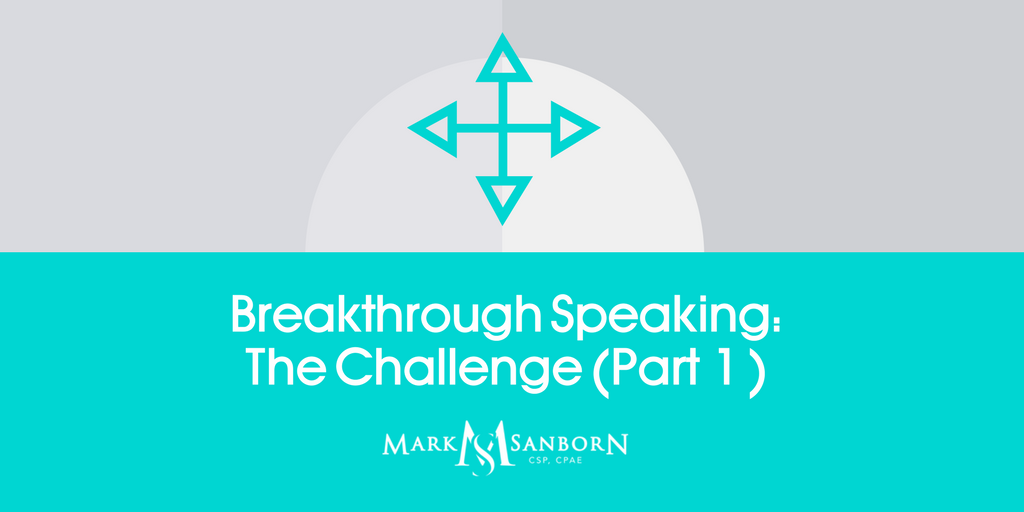(I often advise and coach executives and professional speakers. For leaders, the ability to communicate well and speak persuasively is a critical skill. All professional speakers, myself included, can continue to improve their skills. To answer the questions I’m most frequently asked and share some of the insights I’ve learned from 25 years of professional speaking, I’ve written Breakthrough Speaking. This is the first of the eight part series.)
According to Demosthenes, the ancient Greek known as the father of the speech, the most import principles of public speaking are “action, action, and action.”
Breakthrough speakers inspire listeners to take action.
Anyone with the courage to speak publicly can deliver a speech. The challenge is to deliver a speech that inspires your listeners to action. Public speaking that does not instigate action and change will ultimately be regarded as ineffective.
 The Danish philosopher Søren Kierkegaard offers a parable of a speech that fails to meet the challenge. In the story Tame Geese, a gaggle of barnyard geese listened intently to a wild philosopher goose pontificate about the marvels of flight. He explained that they were born to fly, their wings were designed for it, and that flight was marvelous and liberating. The geese listened with rapt attention to the speech, but at its conclusion they waddled away to feed on the corn of their barnyard. Every time he spoke on the subject, they gathered attentively. Every time he concluded, they waddled back to what they were doing before.
The Danish philosopher Søren Kierkegaard offers a parable of a speech that fails to meet the challenge. In the story Tame Geese, a gaggle of barnyard geese listened intently to a wild philosopher goose pontificate about the marvels of flight. He explained that they were born to fly, their wings were designed for it, and that flight was marvelous and liberating. The geese listened with rapt attention to the speech, but at its conclusion they waddled away to feed on the corn of their barnyard. Every time he spoke on the subject, they gathered attentively. Every time he concluded, they waddled back to what they were doing before.
I’ve related the story of the Tame Geese and asked both aspiring and accomplished speakers,
“Why don’t the geese fly?”
Why didn’t the speech work? Some respond that the geese must be lazy and indifferent. Others say that fear of flying or trying something new keeps the geese grounded. Or maybe habit is the culprit. The geese are used to waddling, and habits are hard to overcome – the problem was with the audience, in other words.
Some see a problem with the speech: the message wasn’t personalized. The philosopher goose spoke only abstractly of flight so the geese couldn’t see how it applied to them personally. And some say the problem is the speaker: the high goose himself doesn’t fly. Since the geese watch what he does, as well as listen to what he says, they lack a role model for flight.
It’s clear that the geese learn from the speech that they can fly – the geese understand intellectually that they are capable of flight – but they never put that understanding to the test. There is, after all, a tremendous leap between what one knows and what one does with that knowledge. And the speech never provides the inspiration to the audience to translate its knowledge into action.
The parable of the pontificating goose and his inability to inspire his audience, the tame geese, to action epitomizes the challenge for anyone who wants to be a breakthrough speaker. Breakthrough speakers inspire listeners to take action.
Fortunately, the skills and techniques required for Breakthrough Speaking are learned, not inherited. There are steps you can take to become a speaker who inspires others to action, ranging from your speaking philosophy to your preparation to your performance. By working through the thoughtful approach outlined in this series, you can meet the challenge of Breakthrough Speaking.
What’s your biggest challenge as a speaker? Please feel free to share your thoughts with me on Facebook and Twitter as well as in the comment box below









I give an annual speech for Kiwanis about foster parents who deserve our praise and support. They are true warriors in our community. I want to open with a message about how we can all do our part to make our community better before we tell their stories. I want to inspire with my message. I find it challenging. I am also a flop at jokes. Where do I get some that relate?
Jackie, I’m going to explain humor in an upcoming post but for now my suggestion is this: don’t tell jokes but use a humorous story that happened to you or someone you know. Don’t take too long to tell it–the longer the story, the bigger the laugh the audience expects–and end with what you thought or learned as a result. That way that humor works as an illustration whether or not people laugh. If you really want to tell a joke, there are many websites and books you can find with a quick Google search, but see if you can’t find something original to talk about that is funny.
Still working on the close. I have a call to action but don’t want to be “salesy” yet want my audience to buy. Working on that diligently.
メガネ オークリー